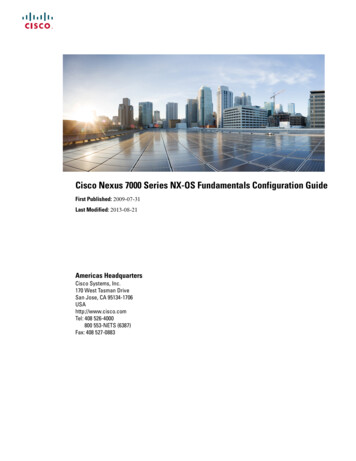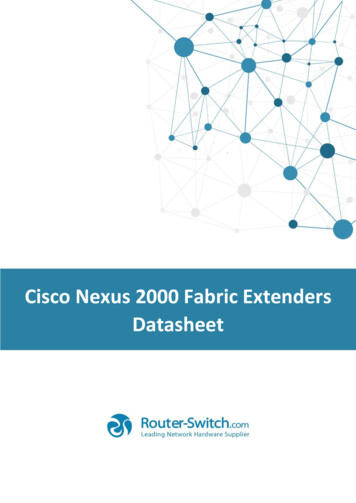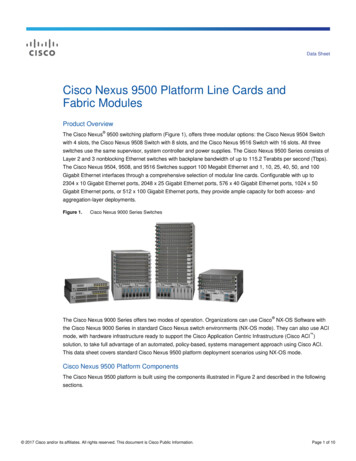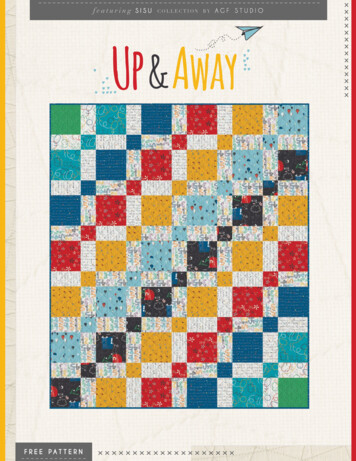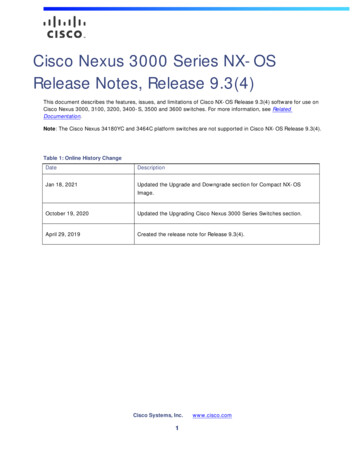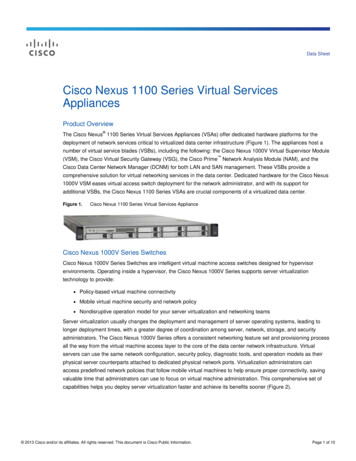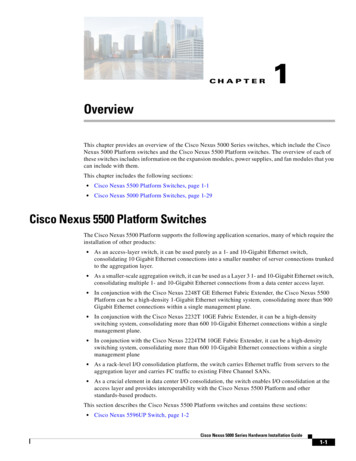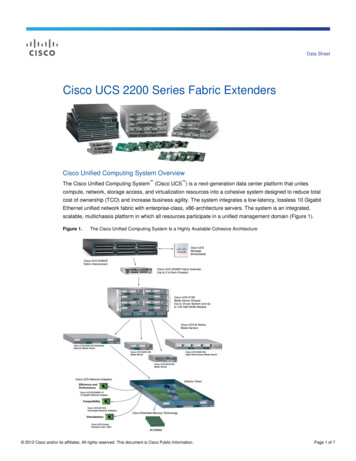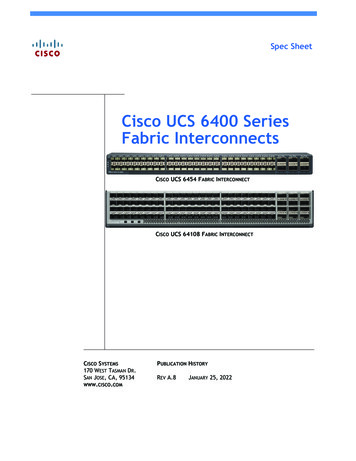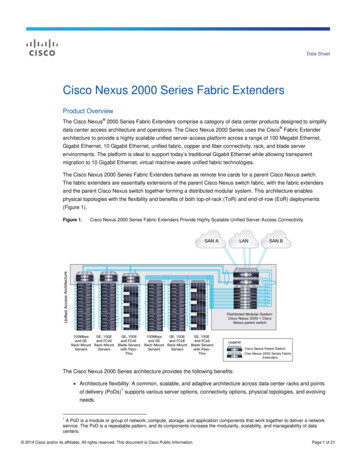
Transcription
Data SheetCisco Nexus 2000 Series Fabric ExtendersProduct OverviewThe Cisco Nexus 2000 Series Fabric Extenders comprise a category of data center products designed to simplifydata center access architecture and operations. The Cisco Nexus 2000 Series uses the Cisco Fabric Extenderarchitecture to provide a highly scalable unified server-access platform across a range of 100 Megabit Ethernet,Gigabit Ethernet, 10 Gigabit Ethernet, unified fabric, copper and fiber connectivity, rack, and blade serverenvironments. The platform is ideal to support today’s traditional Gigabit Ethernet while allowing transparentmigration to 10 Gigabit Ethernet, virtual machine-aware unified fabric technologies.The Cisco Nexus 2000 Series Fabric Extenders behave as remote line cards for a parent Cisco Nexus switch.The fabric extenders are essentially extensions of the parent Cisco Nexus switch fabric, with the fabric extendersand the parent Cisco Nexus switch together forming a distributed modular system. This architecture enablesphysical topologies with the flexibility and benefits of both top-of-rack (ToR) and end-of-row (EoR) deployments(Figure 1).Figure 1.Cisco Nexus 2000 Series Fabric Extenders Provide Highly Scalable Unified Server-Access ConnectivityThe Cisco Nexus 2000 Series architecture provides the following benefits: Architecture flexibility: A common, scalable, and adaptive architecture across data center racks and pointsof delivery (PoDs)1 supports various server options, connectivity options, physical topologies, and evolvingneeds.1A PoD is a module or group of network, compute, storage, and application components that work together to deliver a networkservice. The PoD is a repeatable pattern, and its components increase the modularity, scalability, and manageability of datacenters. 2014 Cisco and/or its affiliates. All rights reserved. This document is Cisco Public Information.Page 1 of 21
Highly scalable server access: Gigabit and 10 Gigabit Ethernet server access is scalable, with no relianceon Spanning Tree Protocol. Simplified operations: One single point of management and policy enforcement using upstream CiscoNexus switches eases the commissioning and decommissioning of server racks through zero-touchinstallation and automatic configuration of fabric extenders. Increased business benefits: Consolidation, cabling reduction, rack-space reduction, reduced power andcooling, investment protection through feature inheritance from the parent switch, and the capability to addfunctions without the need for a major equipment upgrade of server-attached infrastructure all contribute toreduced operating expenses (OpEx) and capital expenditures (CapEx).The Cisco Nexus 2000 Series design aligns with that of servers. It offers front-to-back cooling, compatible with datacenter hot-aisle and cold-aisle designs, all switch ports at the rear of the unit in close proximity to server ports, andall user-serviceable components accessible from the front panel. It also offers back-to-front cooling, with switchports in front of the chassis, aligned with the cold aisle, for optimized cabling in network racks. The Cisco Nexus2000 Series is built for nonstop operation, with redundant hot-swappable power supplies and a hot-swappable fantray with redundant fans. Its compact 1-rack-unit (1RU) form factor takes up relatively little space, making it easy toincorporate into rack designs. The fabric extenders are available in several models to provide speed, connectivity,and port-density options (Figure 2).Figure 2.Cisco Nexus 2000 Series Fabric Extenders from Bottom Right to Top Left: Cisco Nexus 2224TP GE, 2248TP GE,2248TP-E GE, 2232TM 10GE, 2232TM-E 10GE, 2232PP 10GE, and 2248PQ 10GE; Cost-Effective Fabric ExtenderTransceivers for Cisco Nexus 2000 Series and Cisco Nexus Parent Switch Interconnect are in Front of the FabricExtendersThe Cisco Nexus 2000 Series provides two types of ports: ports for end-host attachment (host interfaces) anduplink ports (fabric interfaces). Fabric interfaces, differentiated with a yellow color, are for connectivity to theupstream parent Cisco Nexus switch.Table 1 lists the Cisco Nexus 2000 Series Fabric Extenders. Fabric extenders can be mixed and matched to aparent switch to provide connectivity options.Table 1.Cisco Nexus 2000 Series SpecificationsDescriptionSpecificationCisco Nexus 2148T48t 1000BASE-T host interfaces and 4 10 Gigabit Ethernet fabric interfaces (Enhanced Small Form-FactorPluggable [SFP ])Cisco Nexus 2224TP24 100/1000BASE-T host interfaces and 2 10 Gigabit Ethernet fabric interfaces (SFP )Cisco Nexus 2248TP48 100/1000BASE-T host interfaces and 4 10 Gigabit Ethernet fabric interfaces (SFP )Cisco Nexus 2248TP-E48 100/1000BASE-T host interfaces and 4 10 Gigabit Ethernet fabric interfaces (SFP )Cisco Nexus 2232PP32 1/10 Gigabit Ethernet and Fibre Channel over Ethernet (FCoE) host interfaces (SFP ) and 8 10 GigabitEthernet and FCoE fabric interfaces (SFP )Cisco Nexus 2248PQ48 1/10 Gigabit Ethernet and FCoE host interfaces (SFP ) and 4 QSFP Gigabit Ethernet and FCoE fabricinterfaces (QSFP ) 2014 Cisco and/or its affiliates. All rights reserved. This document is Cisco Public Information.Page 2 of 21
DescriptionSpecificationCisco Nexus 2232TM32 1/10GBASE-T host interfaces and modular uplinks (8 10 Gigabit Ethernet fabric interfaces [SFP ])Cisco Nexus 2232TM-E32 1/10GBASE-T host interfaces and uplink module (8 10 Gigabit Ethernet fabric interfaces [SFP ]), FCoEsupport up to 30m with Category 6a/7 cablesThe Cisco Nexus 2248TP-E Fabric Extender is a general-purpose 1 Gigabit Ethernet fabric extender withenhancements that target workloads such as large-volume databases, distributed storage, and video editing(Figure 3). Like the Cisco Nexus 2248TP, the Cisco Nexus 2248TP-E supports 48 100/1000BASE-T host-facingports and four 10 Gigabit Ethernet fabric interfaces. It also supports 32-MB shared buffers.Figure 3.Cisco Nexus N2248TP-EThe Cisco Nexus 2248PQ 10 Gigabit Ethernet Fabric Extender is the newest member of the Cisco Nexus FabricExtender Family (Figure 4). It supports high-density 10 Gigabit Ethernet environments and has 48 1/10 GigabitEthernet SFP host ports and 4 QSFP fabric ports (16 x 10 GE fabric ports). QSFP connectivity simplifiescabling while lowering power and solution cost. The Cisco Nexus 2248PQ 10GE Fabric Extender supports FCoEand a set of network technologies known collectively as Data Center Bridging (DCB) that increase the reliability,efficiency, and scalability of Ethernet networks. These features allow support for multiple traffic classes over alossless Ethernet fabric, thus enabling consolidation of LAN, storage area network (SAN), and clusterenvironments.Figure 4.Cisco Nexus N2248PQThe Cisco Nexus 2232PP 1/10 Gigabit Ethernet Fabric Extender is an ideal platform for migration from GigabitEthernet to 10 Gigabit Ethernet and unified fabric environments. It supports FCoE and DCB (Figure 5).Figure 5.Cisco Nexus N2232PPThe Cisco Nexus 2232TM-E Fabric Extender supports scalable 1/10GBASE-T environments, ease of migrationfrom 1GBASE-T to 10GBASE-T, and effective reuse of existing structured cabling. It comes with an uplink modulethat supports eight 10 Gigabit Ethernet fabric interfaces. It is a superset of the Cisco Nexus 2232TM with the latestgeneration of 10GBASE-T PHY, enabling lower power and improved bit error rate (BER). The Cisco Nexus2232TM-E supports DCB and LAN and SAN consolidation. FCoE support up to 30m distance with Cat6a and Cat7cables from adapter to FEX (Figure 6). 2014 Cisco and/or its affiliates. All rights reserved. This document is Cisco Public Information.Page 3 of 21
Figure 6.Cisco Nexus N2232TM-ECisco Nexus 2000 Series Fabric Extenders connect to a parent Cisco Nexus switch through their fabric links usingCX1 copper cable, short-reach or long-reach optics, and the cost-effective Cisco Fabric Extender Transceivers.Cisco Fabric Extender Transceivers are optical transceivers that provide a highly cost-effective solution forconnecting the fabric extender to its parent switch over OM3 or OM4 multimode fiber.The Cisco Nexus 2000 Series Fabric Extenders behave like remote line cards for a parent Cisco Nexus 5000,Nexus 6000, or Nexus 7000 Series Switch. Working in conjunction with Cisco Nexus switches, the Cisco Nexus2000 Series Fabric Extenders extend the capabilities and benefits offered by the parent Cisco Nexus switch whileproviding flexible, scalable, and cost-effective server access. Table 2 summarizes the Cisco Nexus 2000 Seriesparent switch support matrix.Table 2.Cisco Nexus Fabric Extender Parent Switch Support MatrixCisco Nexus Parent SwitchCisco Nexus Fabric ExtenderModelsCisco Nexus Parent ModelCisco Nexus 5000 SeriesCisco Nexus 6000 SeriesCisco Nexus 7000 Series Cisco Nexus 2224TP Cisco Nexus 2248TP Cisco Nexus 2224TP Cisco Nexus 2248TP Cisco Nexus 2224TP Cisco Nexus 2248TP Cisco Nexus 2248TP-E Cisco Nexus 2232PP Cisco Nexus 2248TP-E Cisco Nexus 2232PP Cisco Nexus 2248TP-E Cisco Nexus 2232PP Cisco Nexus 2248PQ Cisco Nexus 2232TM Cisco Nexus 2248PQ Cisco Nexus 2232TM Cisco Nexus 2248PQ Cisco Nexus 2232TM Cisco Nexus 2232TM-E Cisco Nexus 2232TM-E Cisco Nexus 2232TM-E Cisco Nexus 5010P or 5020PSwitch* Cisco Nexus 5548P Switch Cisco Nexus 6001 Switch Cisco Nexus 6004 Switch Cisco Nexus 7000 Series32-port 10 Gigabit EthernetModule SFP (N7K-M132XP12) Cisco Nexus 7000 Series32-port 10 Gigabit EthernetModule (XL) SFP (N7KM132XP-12L) Cisco Nexus 7000 Series Linerate 48 port 1/10 GE Ethernetports, SFP/SFP (N7KF248XP-25) Cisco Nexus 7000 Series24-Port 10GE Ethernet ModuleSFP (N7K-M224XP-23L) Cisco Nexus 7000 Seriesenhanced 48-port 1/10 GigabitEthernet SFP (N7K-F248XP25E) Cisco Nexus 7700 Series 48port 1/10 Gigabit Ethernet SFP (N77-F248XP-23E) Cisco Nexus 7000 F3-Series12-port 40-Gigabit EthernetSFP I/O module(N7K-F312FQ-25) Cisco Nexus 7700 F3 Series48-port 1/10-Gigabit EthernetSFP I/O module(N77-F348XP-23) Cisco Nexus 5548UP Switch Cisco Nexus 5596UP Switch Cisco Nexus 5596T Switch Cisco Nexus 5600 SeriesSwitch 2014 Cisco and/or its affiliates. All rights reserved. This document is Cisco Public Information.Page 4 of 21
Cisco Nexus Parent SwitchScalability Up to 24 fabric extenders perCisco Nexus 5600 Series switchin both L2 and L3configurations; Upto 1152Gigabit Ethernet servers and1152 10 Gigabit EthernetServers per switch Up to 24 fabric extenders perCisco Nexus 5548P, Nexus5548UP, or Nexus 5596UPSwitch (16 fabric extenders forLayer 3 configurations); up to1152 Gigabit Ethernet serversand 1152 10 Gigabit Ethernetservers per switch Up to 12 fabric extenders perCisco Nexus 5010P and Nexus5020P Switch: up to 576 GigabitEthernet servers and 384 10Gigabit Ethernet servers perswitch Up to 48 fabric extenders inLayer 2 configurations and up to24 fabric extenders in Layer 3configurations Up to 2304Gigabit Ethernet servers and2304 10 Gigabit Ethernetservers per switch Up to 64 fabric extenders perCisco Nexus 7000 SeriesSwitch with Nexus 7000Supervisor Engine 2E andCisco NX-OS Software Release6.2 Up to 3072 Gigabit Ethernet and3072 10 Gigabit Ethernetservers per Cisco Nexus 7000Series Switch with Nexus 7000Supervisor Engine 2E andCisco NX-OS Software Release6.2BenefitsArchitecture Flexibility Unified server access architecture: The Cisco Nexus 2000 Series offers a highly cost-effective access-layerarchitecture for 100 Megabit Ethernet, Gigabit Ethernet, 10 Gigabit Ethernet, mixed Gigabit Ethernet, and10 Gigabit Ethernet servers; Ethernet or unified fabric; physical or virtual server; and rack or blade serverenvironments. Flexible physical topologies: The Cisco Nexus 2000 Series architecture allows decoupling of the Layer 1and 2 topologies, therefore providing flexibility in designing physical architectures, including ToR, middle-ofrow (MoR), and EoR deployments, while allowing quick expansion of network capacity and remote line-cardportability across multiple parent switches. It is also space-optimized for all these architectures.Highly Scalable Access LayerToday’s data centers must have massive scalability to manage the combination of an increasing number of serversand a higher demand for bandwidth from each server. The Cisco Nexus 2000 Series increases the scalability of theaccess layer to accommodate both sets of demands without increasing management points within the network. Massive scalability: A deployment of Cisco Nexus 2000 Series Fabric Extenders connected to a CiscoNexus 5000, Nexus 6000, or Nexus 7000 Series Switch supports highly scalable Gigabit and 10 GigabitEthernet environments as shown in Table 2. Layer 2 scalability: Reliance on Spanning Tree Protocol is eliminated between the fabric extender and theparent switch, thus enabling a large, multipath, loop-free topology. Use of a single management entity tosupport a large server domain allows policy to be enforced more efficiently and enhances Layer 2 datacenter access scalability. Use of the Virtual PortChannel (vPC) feature also allows fast convergence andeffective use of bandwidth in Layer 2 environments.Simplified Operations Single point of management: The Cisco Nexus 2000 Series Fabric Extenders are remote line cards for aCisco Nexus parent switch. All device configurations are managed on the Cisco Nexus parent switch, andconfiguration information is downloaded to the Cisco Nexus 2000 Series Fabric Extender using in-bandcommunication. 2014 Cisco and/or its affiliates. All rights reserved. This document is Cisco Public Information.Page 5 of 21
Software maintenance simplification: The Cisco Nexus 2000 Series software is embedded in the CiscoNexus parent switch software. The fabric extender is a ready-to-use device that automatically downloadsthe software image from the Cisco Nexus parent switch in the same way that a line card downloadssoftware from the supervisor engine in a modular chassis. In-Service Software Upgrade (ISSU) on the fabricextenders provides the capability to perform transparent software upgrades, reducing downtime andallowing customers to integrate the newest features and functions with little or no effect on networkoperation for Ethernet, storage, and converged network environments. Switch feature consistency across a large number of servers: The Cisco Nexus 2000 Series forwards alltraffic to the parent Cisco Nexus switch over 10 Gigabit Ethernet fabric uplinks. Passing all traffic to theparent switch allows traffic to be shaped according to policies established on the parent Cisco Nexus switchwith a single point of management. Standardizing on the Cisco Nexus switches allows data centers tosupport the same switch features across the entire access layer with a single point of management. Tenfold management points reduction: The number of management points is significantly less than whendiscrete switches are used at the top of the rack. A traditional 12-rack design using a discrete, redundantpair of Gigabit Ethernet switches at the top of each rack has 24 management points. The equivalentarchitecture using the Cisco Nexus 2000 Series has only two management points: a tenfold reduction inmanagement complexity.Business Benefits Cost-effective 10 Gigabit Ethernet solution: The Cisco Nexus 2000 Series is the ideal platform for migrationfrom Gigabit Ethernet to 10 Gigabit Ethernet. Scalable 10 Gigabit Ethernet provides 10 times the bandwidthfor approximately twice the price of Gigabit Ethernet. Consolidation: The Cisco Nexus 2000 Series protects investment into the future, supporting evolving datacenter needs by providing an easy migration path to low-latency 10 Gigabit Ethernet, high-performancecomputing (HPC), virtual machine-aware networks. In addition, the combination of the Cisco Nexus 5000 orNexus 6000 Series and Cisco Nexus 2232PP or Cisco Nexus 2248PQ provides a unified network fabric thatsupports LAN and SAN consolidation. Another benefit of the Cisco Nexus 2000 architecture is the ability tocollapse data center access and aggregation layers into one single layer. Investment protection: The Cisco Nexus 2000 Series Fabric Extenders can be mixed and matched with acommon parent Cisco Nexus switch. New functions can be derived from upstream Cisco Nexus switches,resulting in the capability to add new functions without the need for a major equipment upgrade. Rack-space reduction: The Cisco Nexus 2000 Series consists of 1RU fabric extenders. The fabricextenders are not physically constrained by the position of the Cisco Nexus parent switch in the physicaltopology and are attached to the upstream Cisco Nexus switch through fabric links. Cabling reduction with optimal intra- and inter-rack cabling options: The Cisco Nexus 2000 Series supportsToR, EoR, and MoR deployment models. Placing the fabric extender at the top of the rack allows the use ofshort cables from the rack to servers, reducing cable costs, air dams, complexity, and opportunities forerror. The only inter-rack cabling required is for uplinks from the fabric extender to the parent switch.Placing the parent Cisco Nexus switch at the end or middle of a row of racks makes efficient use of powerfulswitching resources. 2014 Cisco and/or its affiliates. All rights reserved. This document is Cisco Public Information.Page 6 of 21
The Cisco Nexus 2000 Series supports an optimal cabling strategy that simplifies network operations andprepares for future technologies: Short intra-rack runs of copper: Intra-rack cables connecting to Gigabit Ethernet servers can be Category5e, 6, 6a, or 7 with the Cisco Nexus 2148T, Nexus 2224TP, Nexus 2248TP, and Nexus 2248TP-E fabricextenders. Category 6, 6a, or 7 can connect 10GBASE-T servers to the Cisco Nexus 2232TM and Nexus2232TM-E. Twinax cables connect servers to ToR Cisco Nexus 2232PP Fabric Extenders. This modelallows server racks and PoDs to be preconfigured by server vendors so they can be rolled into place andput into service upon arrival. Longer inter-rack horizontal runs of fiber: Cisco Nexus 2000 Series Fabric Extenders in each rack areconnected to parent switches that are placed at the end or middle of the row: For long reach between thefabric extender and the parent switch, Cisco Fabric Extender Transceiver, SFP short-reach (SR), SFP long-reach (LR) optics over OM2 or OM3 cables, and QSFP optics for 40G connectivity can be used.Fiber protects investments into the future because it will support upcoming Ethernet standards, including40 and 100 Gigabit Ethernet. If the distance to the Cisco Nexus 5000, Nexus 6000, or Nexus 7000 SeriesSwitch is less than 10 meters, Twinax cables (CX1 direct attach) can be used. Alternatively, coppercables can be used to reach EoR or MoR 1GBASE-T or 10GBASE-T fabric extenders. Effective bandwidth usage: Today’s data center servers are either single- or dual-homed to the network.However, network designs almost always involve redundant deployment. Through the vPC feature supporton the Cisco Nexus 5000 or Nexus 6000 Series, a server can be dually connected to a pair of fabricextenders, or each fabric extender can be connected to a pair of Cisco Nexus 5000 or Nexus 6000 SeriesSwitches, thus giving customers both server and fabric extender connectivity redundancy and providingactive-active connectivity with twice the bandwidth usage as in active-standby or forwarding-blockingconfigurations. Reduced power and cooling: Cost-effective 10 Gigabit Ethernet solutions, optimal cabling, deviceconsolidation, rack-space reduction, and efficient bandwidth use all contribute to a significant reduction inpower and cooling needs in the data center.Cisco Nexus 2000 Series Deployment ScenariosThe fabric extenders can be used in the following deployment scenarios: Rack servers with 100 Megabit Ethernet, Gigabit Ethernet, or 10 Gigabit Ethernet network interface cards(NICs); the fabric extender can be physically located at the top of the rack and the Cisco Nexus parentswitch can reside in the middle or at the end of the row, or the fabric extender and the Cisco Nexus parentswitch can both reside at the end or middle of the row. 10 Gigabit Ethernet and FCoE deployments, using servers with converged network adapters (CNAs) forunified fabric environments with the Cisco Nexus 2232PP, Nexus 2248PQ, and Nexus 2232TM-E. 1/10 Gigabit Ethernet BASE-T server connectivity with ease of migration from 1 to 10GBASE-T andeffective reuse of structured cabling. Server racks with integrated lights-out (iLO) management, with 100 Megabit Ethernet or Gigabit Ethernetmanagement and iLO interfaces. Gigabit Ethernet and 10 Gigabit Ethernet blade servers with pass-through blades. Low-latency, high-performance computing environments. Virtualized access. 2014 Cisco and/or its affiliates. All rights reserved. This document is Cisco Public Information.Page 7 of 21
For more information, visit the Cisco Nexus 2000 Series case studies rod case studies list.html.The Cisco Nexus 2000 Series can be used in conjunction with a Cisco Nexus parent switch in two main designscenarios (shown in Figure 1): Cisco Nexus 2000 Series Fabric Extenders single-connected to one upstream Cisco Nexus 5000, Nexus6000, or Nexus 7000 Series Switch: In this deployment scenario, access-layer redundancy is achievedthrough redundant server connections to two upstream distributed modular systems using vPC (CiscoNexus 5000 or Nexus 6000 Series) or server NIC teaming to two Cisco Nexus 2000 Series FabricExtenders. Cisco Nexus 2000 Series Fabric Extenders dual-connected to two upstream Cisco Nexus 5000 or Nexus6000 Series Switches (vPC): In this deployment scenario, access-layer redundancy is achieved through acombination of Cisco Nexus 2000 Series Fabric Extenders dual-connected to an upstream parent switchand server NIC teaming. Enhanced vPC (EvPC): In this deployment scenario, access layer redundancy is achieved in two ways:through redundant connections between the Cisco Nexus 2000 Fabric Extenders and the Cisco Nexusparent switches using vPC, and through redundant server connections to two fabric extenders using vPCand active-active server NIC teaming.vPC : In this deployment scenario, access-layer redundancy is achieved through server vPC, FEX vPC,and EvPC. In addition, a vPC domain allows the Cisco Nexus parent switch and the fabric extenders to beviewed as a single virtual switch in a Cisco FabricPath network.Figure 7.Cisco Nexus 2000 Series Fabric Extenders Design Scenarios, from Left to Right: Server vPC, FEX vPC, EvPC,vPC 2014 Cisco and/or its affiliates. All rights reserved. This document is Cisco Public Information.Page 8 of 21
Product SpecificationsTables 3 through 9 provide product specifications and Table 10 lists standards support for the Cisco Nexus 2000Series Fabric Extenders.Table 3.Cisco Nexus 2000 Series Gigabit Ethernet Fabric Extenders Product SpecificationsDescriptionCisco Nexus 2148TCisco Nexus 2224TPCisco Nexus 2248TPCisco Nexus 2248TP-EFabric extender hostinterfaces 48 24 48 48Fabric extender hostinterfaces type 1000BASE-T ports:RJ-45 connectors 100BASE-T/1000BASET ports: RJ-45connectors 100BASE-T/1000BASET ports: RJ-45connectors 100BASE-T/1000BASET ports: RJ-45connectorsFabric extenderfabric interfaces 4 2 4 4Fabric extenderfabric interfaces type Fiber: SFP optics(SFP-10G-SR andSFP-10G-LR) Copper: 10 GigabitEthernet SFP passiveTwinax copper cables(SFP-H10GB-CU1M,SFP-H10GB-CU3M, andSFP-H10GB-CU5M) andactive Twinax coppercables (SFP-H10GBACU7M and SFPH10GB-ACU10M) Distance between CiscoNexus 2000 SeriesFabric Extender andCisco Nexus 5000SeriesSwitch: Up to 3 km Fiber: Cisco FabricExtender Transceiver(FET-10G) and SFP optics (SFP-10G-SRand SFP-10G-LR) Copper: 10 GigabitEthernet SFP passiveTwinax copper cables(SFP-H10GB-CU1M,SFP-H10GB-CU3M, andSFP-H10GB-CU5M) andactive Twinax coppercables (SFP-H10GBACU7M and SFPH10GB-ACU10M) AOC cables:SFP-10G-AOC1M, SFP10G-AOC2M, SFP-10GAOC3M, SFP-10GAOC5M, SFP-10GAOC7M, SFP-10GAOC10M AOC breakout 0G-AOC10M Copper breakout FP10G-CU5M,QSFP-4SFP10GACu7M, and QSFP4SFP10G-ACu10M Distance between CiscoNexus 2000 SeriesFabric Extender andCisco Nexus 5000 orNexus 6000 SeriesSwitch: Up to 3 km Distance between CiscoNexus 2000 SeriesFabric Extender andCisco Nexus 7000Series Switch: Up to10 km Fiber: Cisco FabricExtender Transceiver(FET-10G) and SFP optics (SFP-10G-SRand SFP-10G-LR) Copper: 10 GigabitEthernet SFP passiveTwinax copper cables(SFP-H10GB-CU1M,SFP-H10GB-CU3M, andSFP-H10GB-CU5M) andactive Twinax coppercables (SFP-H10GBACU7M and SFPH10GB-ACU10M) AOC cables:SFP-10G-AOC1M, SFP10G-AOC2M, SFP-10GAOC3M, SFP-10GAOC5M, SFP-10GAOC7M, SFP-10GAOC10M AOC breakout 0G-AOC10M Copper breakout FP10G-CU5M,QSFP-4SFP10GACu7M, and QSFP4SFP10G-ACu10M Distance between CiscoNexus 2000 SeriesFabric Extender andCisco Nexus 5000 orNexus 6000 SeriesSwitch: Up to 3 km Distance between CiscoNexus 2000 SeriesFabric Extender andCisco Nexus 7000Series Switch: Up to10 km Fiber: Cisco FabricExtender Transceiver(FET-10G) and SFP optics (SFP-10G-SRand SFP-10G-LR) Copper: 10 GigabitEthernet SFP passiveTwinax copper cables(SFP-H10GB-CU1M,SFP-H10GB-CU3M, andSFP-H10GB-CU5M) andactive Twinax coppercables (SFP-H10GBACU7M and SFPH10GB-ACU10M) AOC cables:SFP-10G-AOC1M, SFP10G-AOC2M, SFP-10GAOC3M, SFP-10GAOC5M, SFP-10GAOC7M, SFP-10GAOC10M AOC breakout 0G-AOC10M Copper breakout FP10G-CU5M,QSFP-4SFP10GACu7M, and QSFP4SFP10G-ACu10M Distance between CiscoNexus 2000 SeriesFabric Extender andCisco Nexus 5000 orNexus 6000 SeriesSwitch: Up to 10 kmFabric speed 40 Gbps in eachdirection(80 Gbps full duplex) 20 Gbps in eachdirection(40 Gbps full duplex) 40 Gbps in eachdirection(80 Gbps full duplex) 40 Gbps in eachdirection(80 Gbps full duplex)Oversubscription 1.2:1 1.2:1 1.2:1 1.2:1 2014 Cisco and/or its affiliates. All rights reserved. This document is Cisco Public Information.Page 9 of 21
DescriptionCisco Nexus 2148TCisco Nexus 2224TPCisco Nexus 2248TPCisco Nexus 2248TP-EPerformance Hardware forwarding at176 Gbps or 131 millionpackets per second(mpps) Hardware forwarding at88 Gbps or 65 mpps Hardware forwarding at176 Gbps or 131 mpps Hardware forwarding at176 Gbps or 131 mppsCisco parent switch Cisco Nexus 5000Series Cisco Nexus 5000Series Cisco Nexus 6000 Cisco Nexus 5000Series Cisco Nexus 6000 Cisco Nexus 5000Series Cisco Nexus 6000 Cisco Nexus 7000Series Cisco Nexus 7000Series Cisco Nexus 7000Series Cisco NX-OS SoftwareRelease 4.2(1)N2(1)(Cisco Nexus 5000Series) Cisco Nexus 6000Series Switches runningCisco NX-OS SoftwareRelease 6.0 and later Cisco NX-OS SoftwareRelease 5.2 on theCisco Nexus 7000Series Cisco NX-OS SoftwareRelease 4.2 (CiscoNexus 5000 Series) Cisco Nexus 6000Series Switches runningCisco NX-OS SoftwareRelease 6.0 and later Cisco NX-OS SoftwareRelease 5.1 on theCisco Nexus 7000Series Cisco NX-OS SoftwareRelease 5.1(3)N(1)1(Cisco Nexus 5000Series) Cisco Nexus 6000Series Switches runningCisco NX-OS SoftwareRelease 6.0 and later Cisco NX-OS SoftwareRelease 6.1(1) on theCisco Nexus 7000SeriesMinimum software Cisco NX-OS SoftwareRelease 4.0(1A)N2(1)(Cisco Nexus 5000Series)Cisco Nexus 2000 Series Gigabit Ethernet Fabric Extenders EnvironmentDimensions(H x W x D) 1.72 x 17.3 x 20.0 in.(4.37 x 43.94 x 50.8 cm) 1.72 x 17.3 x 17.7 in.(4.37 x 43.94 x 44.96cm) 1.72 x 17.3 x 17.7 in.(4.37 x 43.94 x 44.96cm) 1.72 x 17.3 x 17.7 in.(4.37 x 43.94 x 44.96cm)Weight 18 lb (8.2 kg) *Systems are fullyloaded with two powersupplies and one fantray 16.6 lb (7.53 kg) *Systems are fullyloaded with two powersupplies and one fantray 17.7 lb (8.0 kg) *Systems are fullyloaded with two powersupplies and one fantray 17.7 lb (8.0 kg) *Systems are fullyloaded with two powersupplies and one fantrayIndicator and portspecification System status: Green (operational), amber (fault), flashing amber (POST boot up), and off (no power) Locator LED: Bright blue locator Port status: Green (link established), amber (administratively disabled), and flashing amber (fault) Fan status: Green (operational) and amber (fault) Power status: Green (operational) and amber (fault)Environment Operating temperature: 32 to 104 F (0 to 40 C) Nonoperating temperature: -4 to 158 F (-20 to 70 C) Humidity: 5 to 95 percent (noncondensing) Altitude: 0 to 10,000 ft (0 to 3000m)Power supply N2K-PAC-200W N2200-PAC-400W,N2200-PAC-400W-B,N2200-PDC-400W, andN2200-PDC-350W-B N2200-PAC-400W,N2200-PAC-400W-B,N2200-PDC-400W, andN2200-PDC-350W-B N2200-PAC-400W,N2200-PAC-400W-B,N2200-PDC-400W, andN2200-PDC-350W-BFan tray N2K-C2148-FAN N2K-C2248-FAN andN2K-C2248-FAN-B N2K-C2248-FAN andN2K-C2248-FAN-B N2K-C2248-FAN andN2K-C2248-FAN-BTypical inputoperating power 150W (max 165W) 80W (max 95W) 95W (max 110W) 95W (max 110W)Input current 1.5A/2.2A(typical/maximum) Note: Input currentslisted for 110V; divide by2 for 220V Supply will surge on ACpower-up for a fractionof a second beyond thisrating 0.75A/0.90A(typical/maximum) Note: Input currentslisted for 110V; divide by2 for 220V Supply will surge on ACpower-up for a fractionof a second beyond thisrating 1.0A/1.2A(typical/maximum) Note: Input currentslisted for 110V; divide by2 for 220V Supply will surge on ACpower-up for a fractionof a second beyond thisrating 1.0A/1.2A(typical/maximum) Note: Input currentslisted for 110V; divide by2 for 220V Supply will surge on ACpower-up for a fractionof a second beyond thisratingOutput current 11.5A/16.7A(typical/maximum) 5
Cisco Nexus 2000 Series Fabric Extenders from Bottom Right to Top Left: Cisco Nexus 2224TP GE, 2248TP GE, 2248TP-E GE, 2232TM 10GE, 2232TM-E 10GE, 2232PP 10GE, and 2248PQ 10GE; Cost-Effective Fabric Extender
